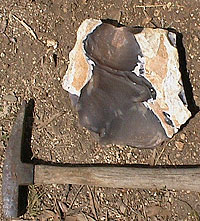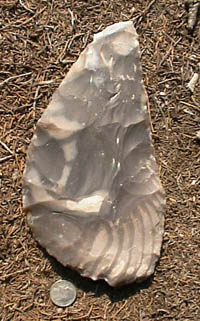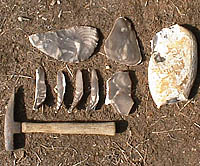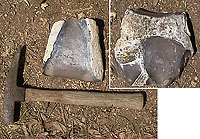Root Beer Flint
Root Beer flint is the name modern flintknappers have given to a variety
of chert that is distinctive and widespread in central Texas. It
is perhaps most abundant in Kimble and Kerr Counties, but also occurs
in several adjacent counties. Similar materials of slightly different
coloration occur as far east as Comal County and as far north as the
Callahan Divide (just south of Abilene). As the name implies, classic
examples of this flint resemble the color of the beverage root beer – dark
brown or grayish brown and translucent on thin edges. In fact, there
is considerable color variation within the general and informal designation,
Root Beer flint. One notable variant resembles chocolate milk, while
another has maroon coloration that sometimes includes an unusual shade
of dark blue. Color variation is often created by 'swirl' patterns
of different grain textures, although the best pieces are homogenous,
dark and translucent.
Root Beer flint often occurs in lag deposits on mesas, divides, and upland plains;
such deposits were left behind hundreds of thousands of years ago by ancient
rivers and streams. It also occurs frequently as outcrops in primary context
within limestone bedrock formations, and can be found in secondary context in
the gravel beds of many streams of the region such as the Llano River. The
primary context deposits occur in the Segovia and Fort Terrett geological formation “members” of
Lower Cretaceous limestone. Similar material, such as that found in Comal
County, occur in different Lower Cretaceous limestone formations.
Because it was widespread, abundant, and of generally good quality, Root Beer flint was an important tool stone for native flintknappers. This flint most commonly occurs as thin, flat cobbles or “slabs” and these are often quite large, with pieces from 12 to 18 inches in length not at all unusual. The flint typically has a thin white to orange colored cortex (outer rind). There are many upland quarry sites in the region--places where the flint is concentrated on or just under the surface and where native flintknappers returned many times to acquire tool stone. Aboriginal knappers had a particular method for reducing the large flat cobbles, or slabs found in upland lag deposits. Many of the cobbles are between 1.5-4 inches (4-10 centimeters) in thickness, and it is common for the innermost portion to be of poor quality. Therefore, the knappers would remove only large flakes from the outer veneer of superior Root Beer flint and discard the cobble. A few large flakes often were removed from both faces of the flat cobbles, leaving bifacial cores that usually were not used again.
At its best, Root Beer flint is a homogeneous material of good quality. It is glassy and translucent, but has a toughness that makes it less brittle than Georgetown flint, for example. One advantage of this quality is that Root Beer flint is less prone to breakage during manufacture. Some contemporary knappers heat treat Root Beer flint at relatively low temperatures of less than 400 degrees F because it won't tolerate the higher temperatures required to heat treat many Texas cherts. Regarding this propensity to overheat easily, one of the top contemporary Texan knappers, Troy Herndon of Dallas, says that "Root Beer will blow up on a hot day!"
![]()



